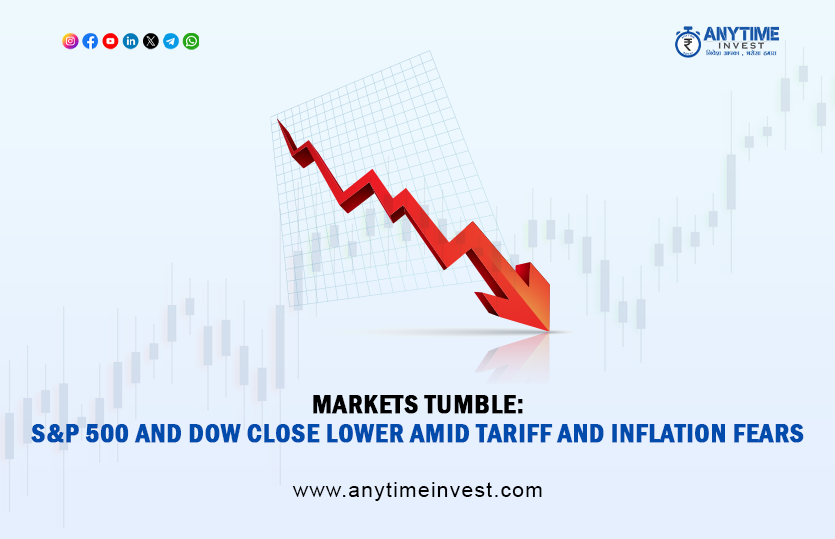
Wall Street saw a sharp selloff this week, with major indexes posting their steepest losses in months. The headline “Markets Tumble: S&P 500 and Dow Close Lower Amid Tariff and Inflation Fears” captured the sentiment perfectly as investors reacted to renewed concerns over inflationary pressures and rising trade tensions.
Increased volatility, driven by a cocktail of economic uncertainties, pushed both the S&P 500 and the Dow Jones Industrial Average into negative territory. For market participants, the headline "Markets Tumble: S&P 500 and Dow Close Lower Amid Tariff and Inflation Fears" was more than just clickbait—it reflected a broader anxiety brewing across global financial markets.
The return of inflation concerns has been a recurring theme this year. With consumer prices climbing at a faster-than-expected pace and core inflation remaining sticky, investors fear that the Federal Reserve may keep interest rates elevated for longer than previously anticipated.
These inflation jitters have cast a shadow over corporate earnings and consumer spending alike. As markets digest incoming data, the refrain “Markets Tumble: S&P 500 and Dow Close Lower Amid Tariff and Inflation Fears” continues to echo across financial headlines. The impact is widespread—from tech giants to small caps—highlighting just how sensitive the market remains to macroeconomic signals.
Adding fuel to the fire, recent geopolitical developments have raised the specter of new trade restrictions. Reports suggest the U.S. may impose fresh tariffs on a range of imported goods, including strategic tech and raw materials. These actions have triggered fears of retaliation from key trade partners, especially China.
In a globalized economy, even the hint of a trade war can send shockwaves through financial markets. The phrase “Markets Tumble: S&P 500 and Dow Close Lower Amid Tariff and Inflation Fears” isn’t just a reaction to short-term headlines—it’s a signal of deeper concern about long-term economic stability and global trade dynamics.
In response to the volatility, investors have been shifting capital into traditional safe havens. U.S. Treasury yields have dipped slightly, while gold and the U.S. dollar saw moderate gains. The equity market, however, bore the brunt of the selloff, with the Dow dropping over 300 points and the S&P 500 losing over 1% in a single session.
As uncertainty grows, many traders and portfolio managers are revisiting their risk strategies. “Markets Tumble: S&P 500 and Dow Close Lower Amid Tariff and Inflation Fears” is not just an article headline—it’s a call to action for investors to recalibrate their positions in anticipation of further market stress.
While the downturn has been broad-based, certain sectors have felt the pain more acutely. Technology stocks, often seen as vulnerable to both rate hikes and supply chain disruptions, led the losses. Semiconductor companies and high-growth tech firms were among the biggest decliners.
Consumer discretionary stocks also pulled back, reflecting growing concerns over purchasing power erosion. As inflation eats into household budgets, companies dependent on consumer spending are facing margin pressure. Once again, the phrase “Markets Tumble: S&P 500 and Dow Close Lower Amid Tariff and Inflation Fears” serves as a summary of the pressure points throughout the market.
With inflation proving more resilient than hoped, the Federal Reserve remains in a tough spot. Though rate cuts were anticipated later this year, recent developments have thrown those expectations into doubt. If inflation continues to run hot, the Fed may be forced to maintain its hawkish stance well into 2025.
This uncertainty around monetary policy adds another layer to the narrative of “Markets Tumble: S&P 500 and Dow Close Lower Amid Tariff and Inflation Fears.” Investors now face a difficult environment where both economic and policy outlooks remain murky.
It’s not just U.S. markets that are feeling the pressure. European and Asian equities have also declined in tandem, reacting to both local economic challenges and the ripple effects from U.S. trade and monetary policies. The phrase “Markets Tumble: S&P 500 and Dow Close Lower Amid Tariff and Inflation Fears” is, therefore, a global phenomenon—signaling a broader sentiment of caution among international investors.
Looking ahead, market watchers expect continued volatility as more economic data is released. Key inflation readings, employment figures, and corporate earnings in the coming weeks will likely determine the next market direction.
While some analysts see the current dip as a potential buying opportunity, others warn that risks remain elevated. Until there's greater clarity on both inflation and trade policy, headlines like “Markets Tumble: S&P 500 and Dow Close Lower Amid Tariff and Inflation Fears” may continue dominating the news cycle.
The recent downturn in equity markets has been sharp, swift, and largely driven by macroeconomic anxiety. The phrase “Markets Tumble: S&P 500 and Dow Close Lower Amid Tariff and Inflation Fears” captures a moment of heightened uncertainty—but also an opportunity for thoughtful analysis and strategic positioning.
As investors navigate this complex environment, staying informed and agile will be key. Whether this marks a temporary correction or the beginning of a larger trend remains to be seen—but for now, the message from Wall Street is clear: caution reigns.